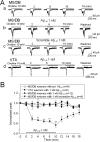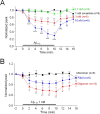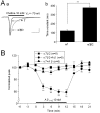A novel nicotinic acetylcholine receptor subtype in basal forebrain cholinergic neurons with high sensitivity to amyloid peptides
- PMID: 19176801
- PMCID: PMC2857410
- DOI: 10.1523/JNEUROSCI.3952-08.2009
A novel nicotinic acetylcholine receptor subtype in basal forebrain cholinergic neurons with high sensitivity to amyloid peptides
Abstract
Nicotinic acetylcholine receptors (nAChRs) containing alpha7 subunits are thought to assemble as homomers. alpha7-nAChR function has been implicated in learning and memory, and alterations of alpha7-nAChR have been found in patients with Alzheimer's disease (AD). Here we report findings consistent with a novel, naturally occurring nAChR subtype in rodent, basal forebrain cholinergic neurons. In these cells, alpha7 subunits are coexpressed, colocalize, and coassemble with beta2 subunit(s). Compared with homomeric alpha7-nAChRs from ventral tegmental area neurons, functional, presumably heteromeric alpha7beta2-nAChRs on cholinergic neurons freshly dissociated from medial septum/diagonal band (MS/DB) exhibit relatively slow kinetics of whole-cell current responses to nicotinic agonists and are more sensitive to the beta2 subunit-containing nAChR-selective antagonist, dihydro-beta-erythroidine (DHbetaE). Interestingly, presumed, heteromeric alpha7beta2-nAChRs are highly sensitive to functional inhibition by pathologically relevant concentrations of oligomeric, but not monomeric or fibrillar, forms of amyloid beta(1-42) (Abeta(1-42)). Slow whole-cell current kinetics, sensitivity to DHbetaE, and specific antagonism by oligomeric Abeta(1-42) also are characteristics of heteromeric alpha7beta2-nAChRs, but not of homomeric alpha7-nAChRs, heterologously expressed in Xenopus oocytes. Moreover, choline-induced currents have faster kinetics and less sensitivity to Abeta when elicited from MS/DB neurons derived from nAChR beta2 subunit knock-out mice rather than from wild-type mice. The presence of novel, functional, heteromeric alpha7beta2-nAChRs on basal forebrain cholinergic neurons and their high sensitivity to blockade by low concentrations of oligomeric Abeta(1-42) suggests possible mechanisms for deficits in cholinergic signaling that could occur early in the etiopathogenesis of AD and might be targeted by disease therapies.
Figures








References
-
- Azam L, Winzer-Serhan U, Leslie FM. Co-expression of alpha7 and beta2 nicotinic acetylcholine receptor subunit mRNAs within rat brain cholinergic neurons. Neuroscience. 2003;119:965–977. - PubMed
-
- Burghaus L, Schütz U, Krempel U, de Vos RA, Jansen Steur EN, Wevers A, Lindstrom J, Schröder H. Quantitative assessment of nicotinic acetylcholine receptor proteins in the cerebral cortex of Alzheimer patients. Brain Res Mol Brain Res. 2000;76:385–388. - PubMed
-
- Counts SE, He B, Che S, Ikonomovic MD, DeKosky ST, Ginsberg SD, Mufson EJ. Alpha7 nicotinic receptor up-regulation in cholinergic basal forebrain neurons in Alzheimer disease. Arch Neurol. 2007;64:1771–1776. - PubMed
-
- Dineley KT, Xia X, Bui D, Sweatt JD, Zheng H. Accelerated plaque accumulation, associative learning deficits, and up-regulation of alpha 7 nicotinic receptor protein in transgenic mice co-expressing mutant human presenilin 1 and amyloid precursor proteins. J Biol Chem. 2002a;277:22768–22780. - PubMed
-
- Dineley KT, Bell KA, Bui D, Sweatt JD. beta-Amyloid peptide activates alpha 7 nicotinic acetylcholine receptors expressed in Xenopus oocytes. J Biol Chem. 2002b;277:25056–25061. - PubMed
Publication types
MeSH terms
Substances
Grants and funding
LinkOut - more resources
Full Text Sources
Other Literature Sources
Molecular Biology Databases
Miscellaneous
